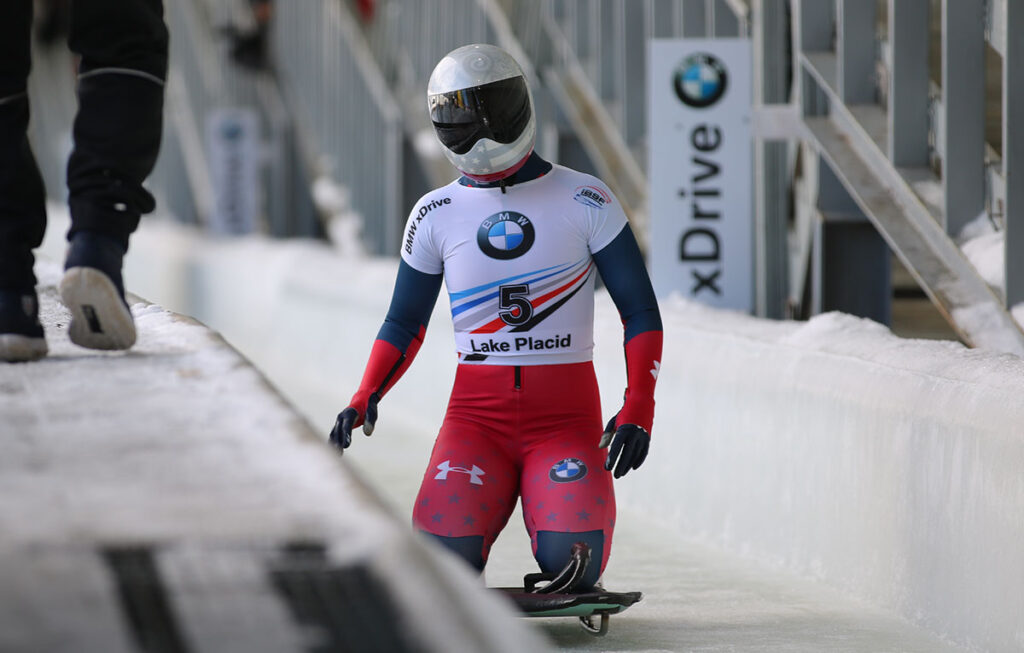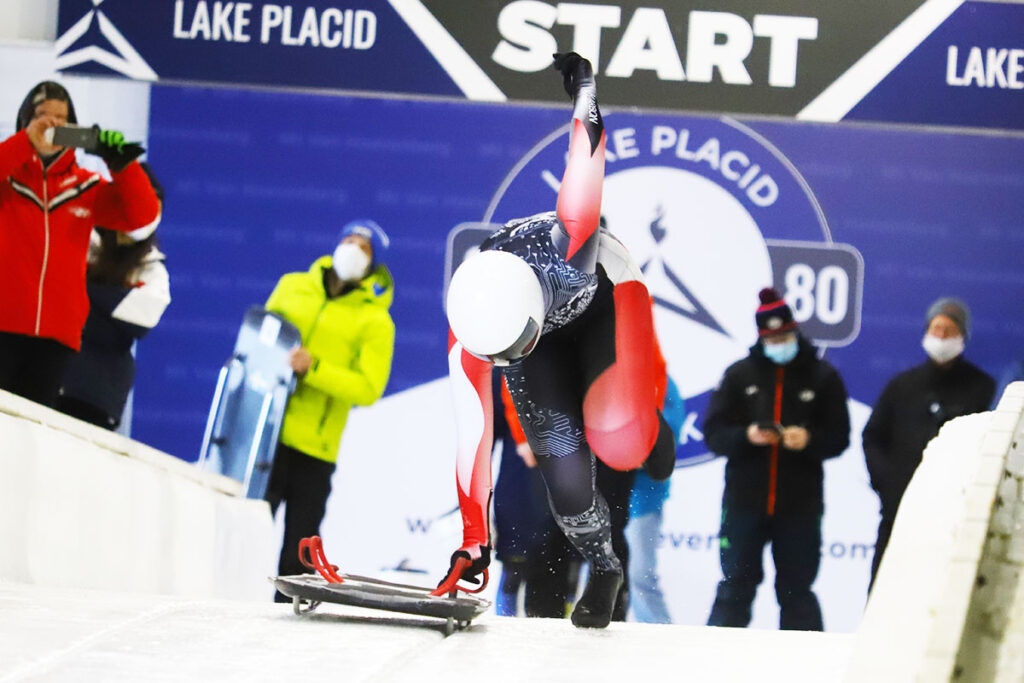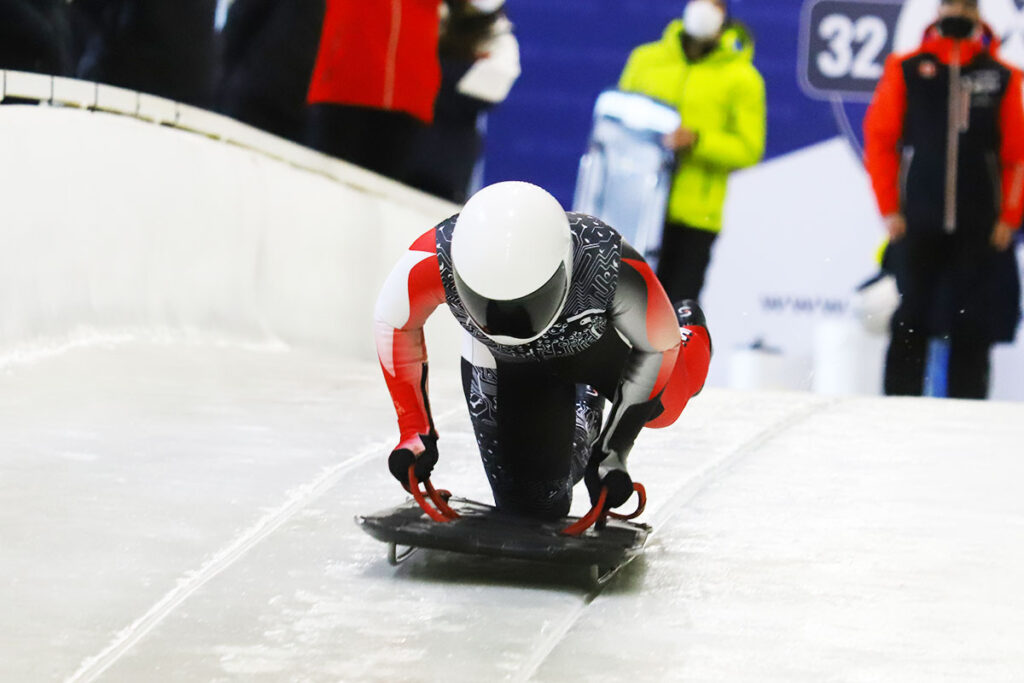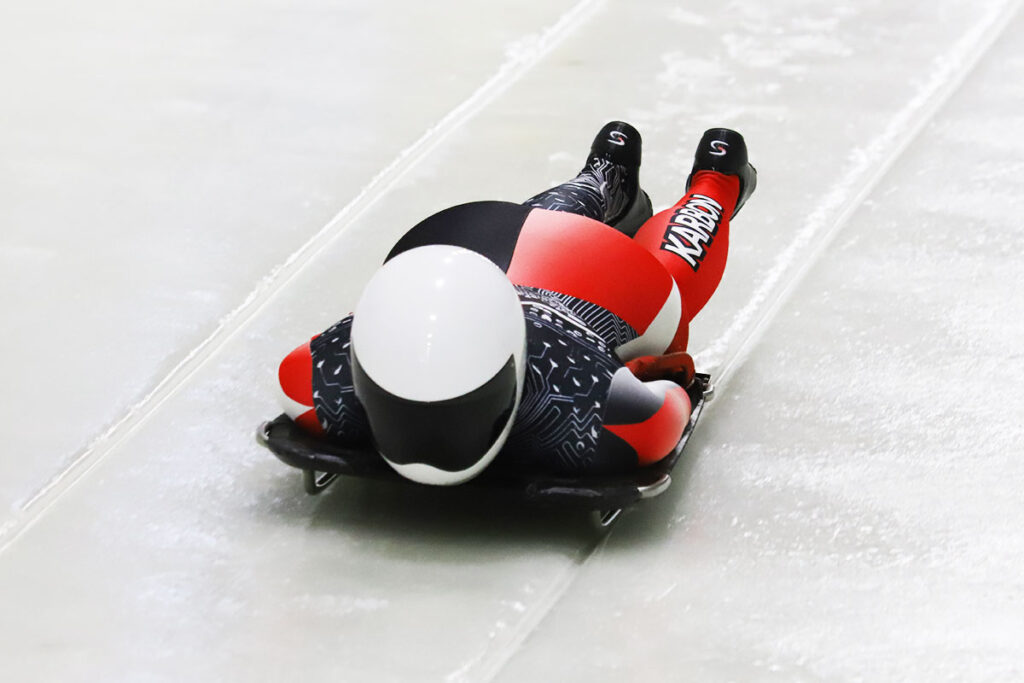Last time we talked about how to luge. This time, we’re going to learn how skeleton athletes complete a run in their sport. We spoke with Canadian national team athlete Grace Dafoe about what it’s like to start and drive a skeleton sled. We’ll start with what you do to get ready, how you push and get on the sled, and then how to steer (yes, they steer) a sled down the track.
First, some skeleton terminology to get us started:
Runner: The polished, rounded steel that touches the ice. Skeleton sleds have a rounded runner that’s smooth on the front half but has a grooved “spine” on the back part.
Rock: The runners aren’t all flat on the ice, there is a bend that can be adjusted to give more or less contact onto the ice.
Spikes: Special shoes with small spikes on the front for better grip on the ice.
Groove: The bobsled start track, skeleton sliders use one of the two bobsled grooves to push their sled before loading in it.
Crest: The bend of the start ramp. Ramps start relatively flat then bend to turn downhill, each track has a different start ramp.
Pressures: The G-forces a slider feels while in a curve
Line: The route a slider takes along the track
Kreisel: A roundabout curve, going anywhere from 270 to 360 degrees. The track for the Beijing Olympics has a 360 degree curve.
Before a Skeleton Run
Like any sliding sport, before a skeleton run you must stop, focus, and mentally prepare for your run. For Dafoe, it’s about getting a clear head.
“My own personal routine…I need to clear my head before I step on the block. I’ll be on the apron before the start block getting ready by taking off my bootie covers and my snow pants or whatever. Then when I get on the block my mind has to be clear and just focused on what’s ahead.”
She continued, “Once I’m on the line I’m trying to stay relaxed. Sometimes I breathe, sometimes I joke with my coach. In Lake Placid he just went “You know, some people are at work today!” And your coach is totally in tune with what you need. Some people like to have their coach put the sled down, I like that because it’s one less thing to think about logistically, some athletes like to put it down themselves.”
Pushing Off the Top
From there it’s time to start your run. Skeleton athletes put their sleds down on the ice, get low, and then explode off the block. The sprint is now done with one hand on the handle, then the athlete loads onto the sled, as demonstrated below by Dafoe.
“You wait for the bell, then you just trust your push technique. I try to think of one queue that is related to the push start. Some are longer, some are shorter. Some I really need to blast off the block, others it’s like a slow burn and I have to get over the crest. Then you load on your sled, take a big breath and then it’s go time! At that point the push is over and now you’re trying to think as little as possible and just that last step to really drive into the sled and then settle in. Then you have to hope that you’re not being pulled either left or right into a wall out of the groove.”
Steering a Sled
Once the sled is in track, it may look like the athletes aren’t doing much of anything, but in fact there’s a lot going on that the athlete is doing to keep the sled going where they want it to. When you think of how someone steers a skeleton sled, you can thing of “heads, shoulders, knees, and toes”, with from the top down the type of steer becomes more aggressive.
“When you’re learning how to slide, a toe-steer is the ultimate ‘drop anchor’ type of safety steer. Obviously the higher up you go in our career they turn more into just little taps, and then at that point it depends on the geometry of the curve and what you’re trying to accomplish.”

From the toe steer being the “anchor drop”, a head steer is a very small adjustment, and can be used to both settle a sled or just help guide the sled where it needs to be.
“A head steer is the smallest form. Especially for skeleton sliders on more touchy sleds like a Bromley sled, a little head steer is usually all you’ll need to get the sled to go where you want it to. Schneider sleds are a little more stubborn and require a little more input I’m told. But coming out of a curve like Shady II in Lake Placid and if you hit it right you can almost just rest your head on the sled and it’ll push it out like you want at the end. At that point it’s just something small: a toe pointing out, just a head lean or something, those are intentional at this level.”
What to Do When Things Go Sideways
Once in a while your sled is going to skid, and then likely hit the wall. Usually this happens when a sled comes off a curve off-line and the athlete is sort of pushed out toward a wall. A lot of times the skid is pretty obvious to the viewer at home, as the sled isn’t as much pointed directly down the track as it is pointing (and probably sliding at) one of the walls. Once this action starts it’s difficult to stop until you get to the next curve, but there are ways you can mitigate the skid.
“It just determines on the angle you’re coming off the curve with. If you’re coming off the corner funny and going to take a hit, you might as well relax and take the hit and kind of mitigate it. The biggest thing is to not try to drive away from where you’re going to hit. Obviously don’t drive into the hit but just let it happen and try to keep that line because it might bounce you back out more in the middle than if you try to steer it. If you’re skidding, that’s where you’ll see some toe taps. Katie Uhlaender is someone who slides like no one else and you can really see where she uses her feet like rudders to kind of get the sled moving. It’s kind of like when you see the runner check on a bobsled, we’re kind of doing that with our toes.”
In Yanqing, there are a few spots along the course where the track runs uphill, then bends back downhill. In luge it has caused a multitude of issues at the bottom of the track. Those portions of the track can be treacherous for a skeleton athlete.
“Sometimes you’ll skid out of a zero-G portion of the track and you don’t have your shoulders in the sled you’ll skid for sure. I think if you’re skidding either your body’s tense on the sled, or you’ve done something that’s caused it and you have to do damage control. That’s where those quick little toe taps come in handy compared to dragging a toe.”

Once an athlete finishes their run there are no brakes. Depending on the track, an athlete will either use their feet to slow down, or slide into mats that have been graciously placed in the middle of the outrun. At one track (Igls), you also run into a wall that has been less-graciously placed.
And that’s how you get down on a skeleton sled!



